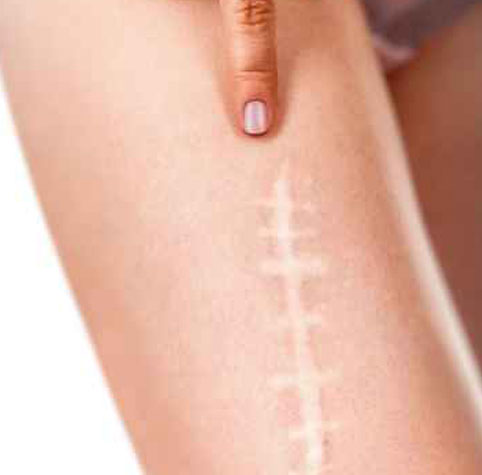Maximise the cosmetic result of your wound
- Promote healthy healing of wounds and scars
Unfortunately it is impossible to prevent scarless surgery. However as a skilled plastic surgeon, Dr Rajapakse is very skilled in minimizing the extent of scarring and also camouflaging and hiding scars.
Bad scars can be a result of past trauma and previous surgery. Dr Rajapakse utilizes a variety of surgical and non surgical techniques to improve unfavorable scarring.
Ultimately, the final appearance of a scar is largely determined by your individual genetic make-up and its anatomical location, with minor contributions to the result from the surgical technique and post-operative care. Although previous scars can be used as a guide to judge the final appearance of a surgical scar, different areas of the body can heal differently and the possibility of a scar should always be considered when deciding to undergo a surgical procedure.
Apart from expert wound-care, several other factors can influence the outcome of your wound. Maintaining a healthy diet and lifestyle will ensure that all the necessary building blocks for wound repair are present. Keeping fit and undertaking regular exercise will improve the circulation and allow a healthy blood flow to the healing area, improving wound healing.
Cigarettes contain many substances that are detrimental to wound healing and to your general health and you should stop smoking where possible. Most elective plastic surgery procedures will not be undertaken until you have quit smoking because of the high risk of complications during your anaesthesia and in the post-operative period.

“Holistic Plastic Surgery in a professional environment Holistic Plastic Surgery in a professional caring environment Holistic Plastic Surgery.”
Dr Yosanta Rajapakse
Wound scar revision FAQs
Is it right for me?
Occasionally, some people will form bad scars, which can detract from an otherwise good surgical result, and largely cannot be anticipated by your surgeon. These can be widespread, hypertrophic, or keloid scars.
Widespread scars are scars that stretch sideways over time and usually occur on the back, breast, or abdomen. This is due to the thickness of the skin in these areas, the time they take to strengthen, and the constant motion to which they are subjected.
Hypertrophic scars are thick, red scars that develop in the first few months. These will often improve with time and massage, but they can sometimes require additional treatment to achieve an acceptable final result. This may include some form of pressure therapy, application of silicon gel sheeting, or in some instances the injection of a steroid solution in order to soften and flatten the scar. Laser therapy can also be used to reduce the redness in the scar. Sometimes a surgical scar revision is required to achieve a desirable result.
Keloid scars are a severe form of hypertrophic scarring in which the area of abnormal scar formation extends beyond the bounds of the original wound. These are uncommon, but can be very difficult to treat. They will often recur after a scar revision.
Will I need anaesthesia?
Depending on the size and location of the skin lesion Dr Rajapakse performs surgery either under local anaesthesia with or without sedation or under general anaesthesia. Some procedures may be suitable for local anaesthetic and can be performed in the rooms.
If general anaesthesia or sedation is required Dr Rajapakse will engage the services of a qualified anaesthetist who is a fellow of the Royal Australian and NZ College of Anaesthetists (FRANZCA).
Your anaesthetist will ask you about all the medications that you are taking or have taken and any allergies that you may have.
Where is the surgery taking place?
All surgeries are performed either as a day case or over night stay at reputable internationally accredited facility.
What is the recovery period?
The recovery period depends on the extent of the scar revision and area of the body. Depending on the site you could be return to work form 1 to 7 days.
What are the costs?
You have the right to be informed about the costs associated with you surgery.
When choosing a surgeon for your reconstructive surgery, remember that factors such as surgeon’s training, qualifications, experience and your comfort them are just as important.
Most hand surgery procedures are covered by private health insurance and carry an MBS code. If your policy covers these item numbers then you are in luck as your insurance will cover a large portion of your hospital and operation costs. If you don’t have private insurance, medicare will reimburse you a portion of the cost (if you are an Australain Resident.)
Costs associated with the procedure may include:
- Dr Rajapakse’s surgical fee
- One year of Surgical follow up
- Accredited hospital facility cost
- Anaesthesia fee
- Prescription for medications
- Post- surgery garments
- Medical tests
After your consultation an informed financial consent will be sent as well as an information pack to read before the second pre-surgery appointment. This second optional appointment is free of charge and your preoperative photos and measurements for any compression garment taken (if required).
Send an enquiry or call (02) 8964 8090

